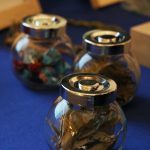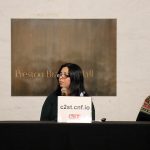By Katie Rice
Medill Reports
When Gina Roxas was about four years old, she was hospitalized with a diagnosis of pneumonia.
Heartbroken at being separated from her family, she ripped the IVs out of her arms, cried and refused to eat while in the hospital. Her condition deteriorated, and doctors had to restrain her.
One day, her father came to visit her and told doctors he’d see what he could do about his daughter’s illness.
“He grabbed me, wrapped me in a blanket and walked out the door,” Roxas said. “And he [carried me to] my great-grandmother’s (house) and gave me to her. And she healed me. She healed me with her prayers, with her teas and with her herbal rubs. It’s not scientifically proven that I was healed, but I’m still here, right?”
Roxas, a member of the Prairie Band Potawatomi, believes in the power of medicinal plants, especially when they are coupled with traditional indigenous healing practices. She manages the Medicinal Garden Project at Schaumburg’s Trickster Art Gallery and hopes to keep indigenous ethnobotanical practices alive through community education.
“It’s those types of traditions, those types of teachings that I’d really like to capture and be able to share,” she said.
Roxas, along with teacher and arborist Adam Kessel and Northwestern University anthropologist Eli Suzukovich, led a panel on “Indigenous Science: Ethnobotany and Conservation Practices” at the Chicago Cultural Center on Wednesday. The panel, sponsored by the Chicago Council on Science, the Trickster Art Gallery and Chicago City Markets among other organizations, was part of the Illinois Bicentennial celebrating statehood – the official 200th birthday is this Monday – and an initiative to include indigenous voices in programming.
“We’re here, and we’re strong, and we have 12,000 years of knowledge that we can share and that we can learn from and help each other,” Roxas said. The Potawatomi are a tribe of the Great lakes areas.
“We’ve always been connected to the land and to plants and to gardening. That’s where my knowledge comes from, from my family,” she said, showing the audience pictures of five generations of her family gardening, from her grandmother standing in a community garden at a reservation to Roxas’ children gardening at the Trickster Art Gallery.
The United States Department of Agriculture defines ethnobotany as the study of how people of a culture or region use the plants that are native to their area. The variety and uses of native plants are just as unique to a group’s culture as the groups are ethnically diverse from one another. The University of Michigan-Dearborn has a searchable database of Native American ethnobotany by scientific and common names that sorts plants by the tribes that use them.
Kathleen McDonald, the executive director of the Mitchell Museum of the American Indian in Evanston, began the program by recognizing the indigenous groups of Illinois, whom she called “the first stewards of this land.”
“As many groups across the state of Illinois are celebrating the 200th anniversary of Illinois’ statehood, we are glad to present a program based not on the settlers, but the first people of this land, the first and continuing caretakers,” she said.
Adam Kessel, of Lakota and Italian descent, said he first became involved with ethnobotany at the American Indian Center of Chicago (AIC), where he served as the coordinator of professional development for four years. During his time at the AIC, the organization received a grant from the National Science Foundation to fund Native educators and “reframe the way that we would teach science,” he said.
The AIC used the grant to start a medicinal herb garden at the center. The garden is still used to cultivate plants such as tobacco used for ceremonies, prayer and healing, Kessel said, and that makes it a unique space in a state that makes access to harvesting these herbs difficult.
“The state of Illinois doesn’t have any federally recognized tribes, nor does it have any federally recognized lands for any of our regional tribes here,” he said.
“What that means for folks is that a lot of times, you’ve got to go really far to get the plants that you need — indigenous people don’t have harvesting rights here, so that makes it difficult to acquire the plants that are needed for ceremonies to practice different tribal spiritualities”
He said the city “wasn’t all that excited” about the growing of native plants on the property, especially since native plants tend to be confused with weeds. But as the plants grew, so did the public’s understanding about Chicago’s native plant populations. The garden offered another opportunity to use the land as a classroom. “If land’s our teacher, then we could teach anywhere,” he said.
Before the panel, Roxas oversaw a table with examples of ceremonial and medicinal plants and explained the function of those displayed — tobacco, sage and cedar, among others — to attendees.
During her portion of the panel, Roxas shared some of the Potawatomi words for various ethnobotanical plants and practices — “ndamnuk” (corn), “mshkuke’ ” (medicine), “nInse’ma” (tobacco) and “wabshkukbyag” (sage).
In her discussion of the cultural significance of native crops, she discussed the legend of the Three Sisters, corn, beans and squash, and spoke about how these three crops complement each other from growth to nutrition. The plants are grown in clusters, with stalks of the corn plants stabilizing the bean plants, and the squash, which grows low to the ground, providing a “living mulch” for the trio, Roxas said.
This mutually beneficial arrangement of the Three Sisters does not occur naturally, but as a result of cultivation by Native tribes. The Three Sisters have much to teach people about sustainable ways of growing and eating, she said.
“This cannot happen without human input,” Roxas said. “This is an example of how we can be connected with our plants, our plant nations, and with the environment.”
Asked whether non-Native communities could enjoy the benefits of ethnobotanical practices without exploiting Native cultures, the panelists agreed that the practices should be shared and that plants are accessible to all. But people should be respectful of the origins of certain practices.
“The more folks know about (ethnobotany), the more it becomes something that is embedded in what we do,” Kessel said. “And it’s important to build that relationship with place. If folks don’t care that our native plants are medicine, why would they care about conserving our natural spaces? And that’s something that impacts Native and non-Native communities.”
Suzukovich, a member of the Little Shell Band of Chippewa-Cree and a Krajina Serb, said cultural appreciation can start with a person’s own culture and expand outward, but people should respect the plants and be mindful of their functions.
“Every culture has a relationship with plants,” Suzukovich said. “And I think people need to look into who they are and what their traditions are and start there, but you have to get an appreciation that plants can do a lot of good things for you (and) they can do a lot of bad things for you if you don’t know what you’re doing.”
Audience member Sandy Langan emphasized the need to ask permission of the Earth and its plants before harvesting anything and to thank them once harvesting is completed. Her comment fittingly closed the panel.
Langan, an herbalist and former organic produce grower, said she attended the panel to learn more about ethnobotany. Langan said she is Ojibwe and a member of the Bad River Band of the Lake Superior Tribe of Chippewa (Ojibwe) Indians in northern Wisconsin.
She said while she did not learn anything new from the panel, she enjoyed listening to the audience’s questions and hearing different perspectives. The question about non-Native people using traditionally Native forms of medicine and ethnobotany particularly stuck with her.
“All I could think of is the plants don’t belong to anybody,” she said. “They give their medicine freely, and it doesn’t belong to any particular race or any ethnic culture any more than Chinese medicine belongs to the Chinese or Ayurveda for (the) Indians, and you find plant medicine to be a worldwide thing.
“It belongs to everybody. It’s the plant’s gift to us. It’s not any more Native American than any other medicine. When I have a headache, I take aspirin and use Western medicine.”








